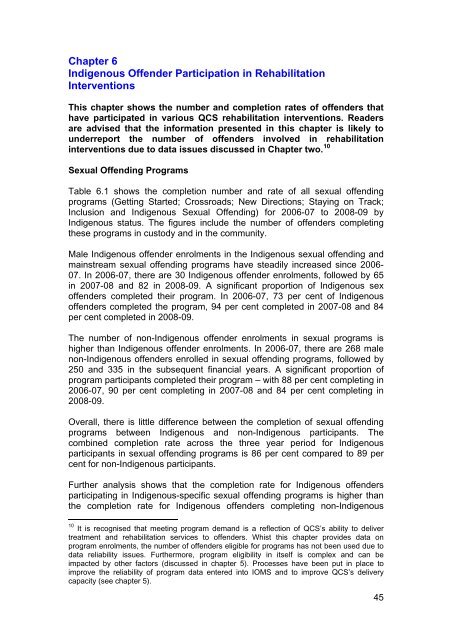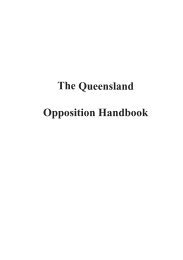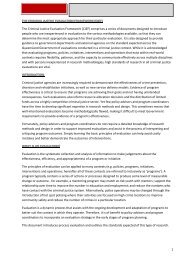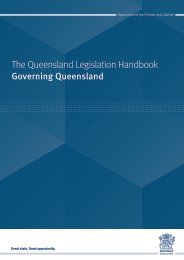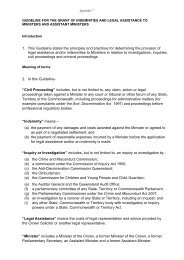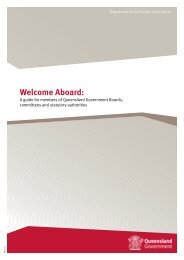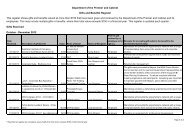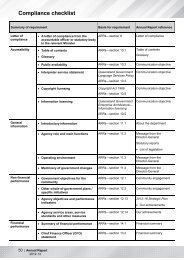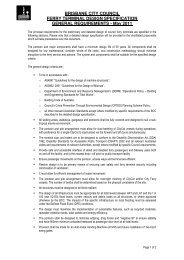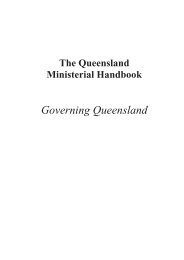Rehabilitative needs and treatment of Indigenous offenders in ...
Rehabilitative needs and treatment of Indigenous offenders in ...
Rehabilitative needs and treatment of Indigenous offenders in ...
Create successful ePaper yourself
Turn your PDF publications into a flip-book with our unique Google optimized e-Paper software.
Chapter 6<strong>Indigenous</strong> Offender Participation <strong>in</strong> RehabilitationInterventionsThis chapter shows the number <strong>and</strong> completion rates <strong>of</strong> <strong>of</strong>fenders thathave participated <strong>in</strong> various QCS rehabilitation <strong>in</strong>terventions. Readersare advised that the <strong>in</strong>formation presented <strong>in</strong> this chapter is likely tounderreport the number <strong>of</strong> <strong>of</strong>fenders <strong>in</strong>volved <strong>in</strong> rehabilitation<strong>in</strong>terventions due to data issues discussed <strong>in</strong> Chapter two. 10Sexual Offend<strong>in</strong>g ProgramsTable 6.1 shows the completion number <strong>and</strong> rate <strong>of</strong> all sexual <strong>of</strong>fend<strong>in</strong>gprograms (Gett<strong>in</strong>g Started; Crossroads; New Directions; Stay<strong>in</strong>g on Track;Inclusion <strong>and</strong> <strong>Indigenous</strong> Sexual Offend<strong>in</strong>g) for 2006-07 to 2008-09 by<strong>Indigenous</strong> status. The figures <strong>in</strong>clude the number <strong>of</strong> <strong>of</strong>fenders complet<strong>in</strong>gthese programs <strong>in</strong> custody <strong>and</strong> <strong>in</strong> the community.Male <strong>Indigenous</strong> <strong>of</strong>fender enrolments <strong>in</strong> the <strong>Indigenous</strong> sexual <strong>of</strong>fend<strong>in</strong>g <strong>and</strong>ma<strong>in</strong>stream sexual <strong>of</strong>fend<strong>in</strong>g programs have steadily <strong>in</strong>creased s<strong>in</strong>ce 2006-07. In 2006-07, there are 30 <strong>Indigenous</strong> <strong>of</strong>fender enrolments, followed by 65<strong>in</strong> 2007-08 <strong>and</strong> 82 <strong>in</strong> 2008-09. A significant proportion <strong>of</strong> <strong>Indigenous</strong> sex<strong>of</strong>fenders completed their program. In 2006-07, 73 per cent <strong>of</strong> <strong>Indigenous</strong><strong>of</strong>fenders completed the program, 94 per cent completed <strong>in</strong> 2007-08 <strong>and</strong> 84per cent completed <strong>in</strong> 2008-09.The number <strong>of</strong> non-<strong>Indigenous</strong> <strong>of</strong>fender enrolments <strong>in</strong> sexual programs ishigher than <strong>Indigenous</strong> <strong>of</strong>fender enrolments. In 2006-07, there are 268 malenon-<strong>Indigenous</strong> <strong>of</strong>fenders enrolled <strong>in</strong> sexual <strong>of</strong>fend<strong>in</strong>g programs, followed by250 <strong>and</strong> 335 <strong>in</strong> the subsequent f<strong>in</strong>ancial years. A significant proportion <strong>of</strong>program participants completed their program – with 88 per cent complet<strong>in</strong>g <strong>in</strong>2006-07, 90 per cent complet<strong>in</strong>g <strong>in</strong> 2007-08 <strong>and</strong> 84 per cent complet<strong>in</strong>g <strong>in</strong>2008-09.Overall, there is little difference between the completion <strong>of</strong> sexual <strong>of</strong>fend<strong>in</strong>gprograms between <strong>Indigenous</strong> <strong>and</strong> non-<strong>Indigenous</strong> participants. Thecomb<strong>in</strong>ed completion rate across the three year period for <strong>Indigenous</strong>participants <strong>in</strong> sexual <strong>of</strong>fend<strong>in</strong>g programs is 86 per cent compared to 89 percent for non-<strong>Indigenous</strong> participants.Further analysis shows that the completion rate for <strong>Indigenous</strong> <strong>of</strong>fendersparticipat<strong>in</strong>g <strong>in</strong> <strong>Indigenous</strong>-specific sexual <strong>of</strong>fend<strong>in</strong>g programs is higher thanthe completion rate for <strong>Indigenous</strong> <strong>of</strong>fenders complet<strong>in</strong>g non-<strong>Indigenous</strong>10 It is recognised that meet<strong>in</strong>g program dem<strong>and</strong> is a reflection <strong>of</strong> QCS’s ability to deliver<strong>treatment</strong> <strong>and</strong> rehabilitation services to <strong>of</strong>fenders. Whist this chapter provides data onprogram enrolments, the number <strong>of</strong> <strong>of</strong>fenders eligible for programs has not been used due todata reliability issues. Furthermore, program eligibility <strong>in</strong> itself is complex <strong>and</strong> can beimpacted by other factors (discussed <strong>in</strong> chapter 5). Processes have been put <strong>in</strong> place toimprove the reliability <strong>of</strong> program data entered <strong>in</strong>to IOMS <strong>and</strong> to improve QCS’s deliverycapacity (see chapter 5).45


